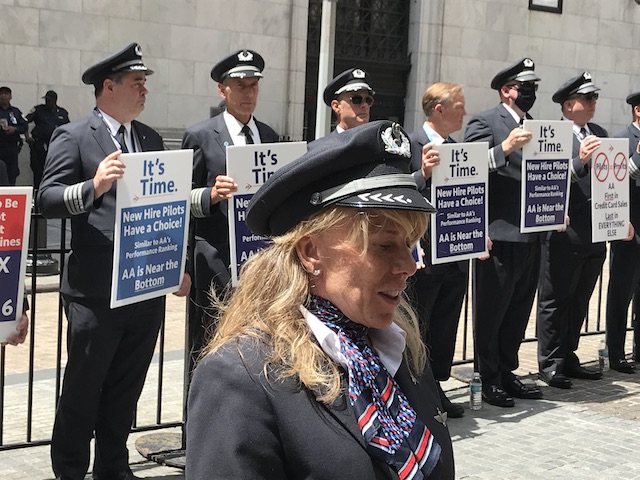NEW YORK, N.Y.—Saying their pushed-to-the-limit schedules are disrupting both passenger service and their ability to get enough rest to do their jobs, about 200 American Airlines pilots held a silent protest outside the New York Stock Exchange June 2.
Dressed in full uniform, they lined up in single file along opposite sides of the cobblestoned plaza in front of the entrance on Broad Street, the shoebox-shaped area suddenly empty of tourists. They held signs reading “STOP the Uncertainty,” “Listen to the Pilots,” and “Reliable Schedules for Pilots = Reliable Schedules for Passengers.” When they switched from the line on the sunny side to the one on the shady side, they did it in order, one by one. As the pilots dispersed, an exchange security guard remarked that it was the most orderly protest he’d ever seen.

Pilots said their schedules are anything but orderly. “Our schedules are made out to the max. If there’s any glitch, it falls apart,” Capt. Gemma Meehan, an Air Force veteran who has been flying for American since 1992, told LaborPress. Federal air regulations limit pilots to nine hours of flying time and 14 hours of duty time in a 24-hour period, she explained, but American typically schedules them for 8 hours, 45 minutes of flying and 13½ hours on duty — “so if there’s any delay, we’re not legal for the next flight.”
That often means sudden and drastic changes, says Capt. Sander Mertz. For example, he says, a pilot could be flying to Washington, scheduled to do a flight to Boston next, and “halfway through that flight, the company could notify them that instead of going from Washington to Boston, you’re going from Washington to Las Vegas.”
“I’m packing a swimsuit and a parka, because I don’t know where I’ll end up,” says Capt. Dennis Tajer, a spokesman for the Allied Pilots Association, who began flying for American 30 years ago, after serving in the Air Force during the first Iraq war.
The sudden changes lead to other disruptions, says Capt. Andy Gomez, who’s been flying for American for 23 years and is based at Dallas-Fort Worth Airport, the airline’s hub. Sometimes when he’s reassigned to a different trip and has to go to another city for a layover, they don’t have a hotel room, so he has to spend time finding one on his own. That cuts into his rest time, he adds, so “the next morning’s flight scheduled for 7, it’s going to leave at 9.”
The pushed-to-the max schedules also don’t take account of weather, Gomez adds. “It’s a good-weather airline,” he says. “Whenever there’s bad weather, they don’t have the resources to get back on track. They don’t have the staffing to resolve things.”
That can lead to hundreds of flights being cancelled as the airline scrambles to find pilots and crew — “binge cancellations,” says Tajer. Over the Memorial Day weekend, U.S. airlines cancelled more than 2,500 flights, with American cancelling 193 on May 30-31 and delaying several hundred more, largely due to severe thunderstorms in Miami. On June 2, American cancelled 412 flights, one-eighth of its schedule. They were among more than 1,370 cancelled nationwide on a day that saw storms in the New York-Newark and Dallas-Fort-Worth areas.
About one-fifth of the cancellations are because “they don’t have enough pilots,” Tajer told LaborPress. There’s “very little buffer,” he said. “It’s a system at risk.”
American’s press office did not respond to a request for comment from LaborPress.
The situation was bad before COVID, says Mertz, but now there are “fewer pilots doing more flying.” American suffered, he adds, because it was the only airline that furloughed pilots during the pandemic, which meant that they had to spend two or three months being retrained to qualify to fly again.
The Allied Pilots Association’s [APA] negotiating committee has proposed several ideas to make scheduling more reliable. They include giving pilots more freedom to trade flight assignments, notifying pilots about changes by electronic messages instead of in-person, and leaving more slack in pilots’ schedules. But management “won’t listen to our fixes,” says Meehan.
“They don’t trust us,” said Tajer. “We want the ability to fly when you need us to fly and have some semblance of a family life.”
The APA has been in contract talks with American for more than three years, since January 2019. One problem, Tajer explains, is that because airlines are considered essential public transportation, they are covered by the federal Railway Labor Act, under which unions cannot legally strike without government authorization. That means negotiations do not have the deadline of a contract expiring.
“Management teams have exploited this for decades to ‘save labor costs,’” he says. “It’s a legalized scam to exploit the clock and the calendar.”
He recalls being furloughed in 1993, early in his career — and when he came back three years later, doing informational picketing because the same contract was still being negotiated.
The point of protesting at the Stock Exchange, Tajer says, was to warn investors, “your investment is being squandered.” American spent more than $12 billion buying back its own stock in the six years before the pandemic hit, high even by the standards of other U.S. airlines.
But it’s below industry standards on pay, benefits, and vacation time, says Gomez. “We’ve offered solutions,” he adds, “but they’re happy doing things on the cheap, and being eighth, ninth, tenth on all the metrics. We’re not.”
“Gross mismanagement placed understaffed American Airlines in a precarious situation when its executives spent billions of dollars on stock buybacks rather than maintaining cash reserves, reducing its enormous debt, and investing in the staffing and well-being of its cabin crews and contract employees,” noted labor strategist Ray Rogers said.
APA President Capt. Eric Ferguson issued a statement saying, “We’re all tired of American Airlines being the industry laggard.”
“It’s time to fix American Airlines, and it’s time for American Airlines to listen to its front-line leadership — its pilots,” he said.



